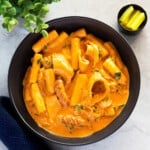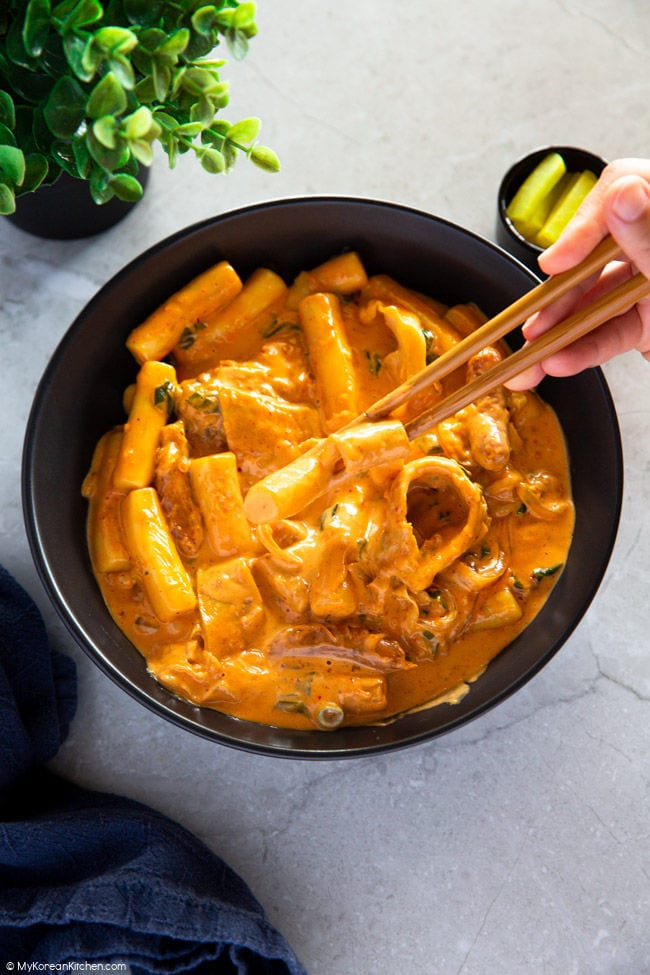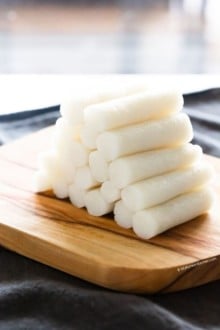If you ever want to indulge in some trendy and delicious Korean food, then Rose Tteokbokki should definitely be on your list. This fusion dish has taken the country by storm, with its creamy and mildly spicy flavor profile that everyone seems to be obsessed with. Learn how to make this dish at home! It’s so easy and quick!
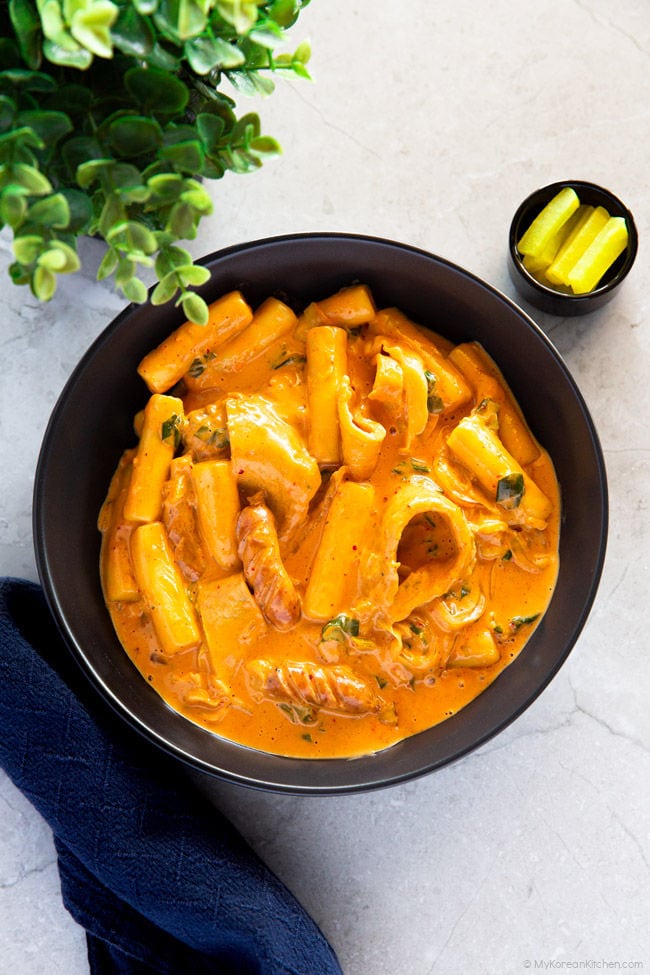
What is Rose Tteokbokki
Rose Tteokbokki is a dish made of chewy Korean rice cakes simmered in a spicy, sweet, and creamy sauce. This variation of tteokbokki is less fiery than the traditional recipe and offers a creamy, mild flavor that even those who are not accustomed to spicy dishes can enjoy.
The original rosé sauce is a blend of tomato sauce and cream, creating a beautiful pinkish-orange hue and it is used as a pasta sauce. Rosé tteokbokki follows the same principle but, instead of using tomato sauce, it uses gochujang based spicy Korean chili sauce. This is why this dish is called “Rose Tteokbokki”.
It can be ready in just 30 minutes, making it a great option for a quick meal or snack.
What Does Rose Tteokbokki Taste Like
Rose tteokbokki has a cheesy, creamy flavor with a hint of Korean spiciness. While I don’t think it is overly spicy, I’m used to Korean spicy food so it may be mildly spicy to some.
Nevertheless, my family can attest that this rose tteokbokki always satisfies us immensely with its heavenly taste.
How to Serve
Typically, rose tteokbokki is served with yellow pickled radish, and some restaurants might also serve Korean steamed egg (gyeranjjim) with it. You can also pair it with Korean rice balls and kimbap to create even more substantial meal options.
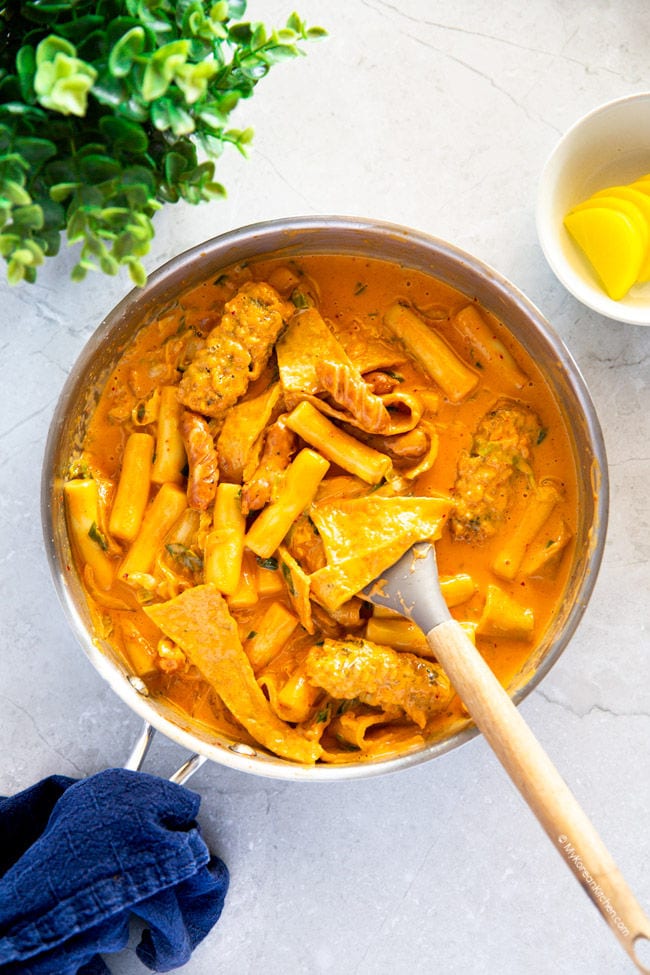
Other Korean Street Foods You Might Like
Are you a fan of street food? If so, my recipes below are definitely worth exploring; they are popular for good reasons!
Additionally, be sure to check out my Toowoomba Pasta recipe. It features an equally divine yet distinct rose sauce that will give you a unique and pleasing taste.
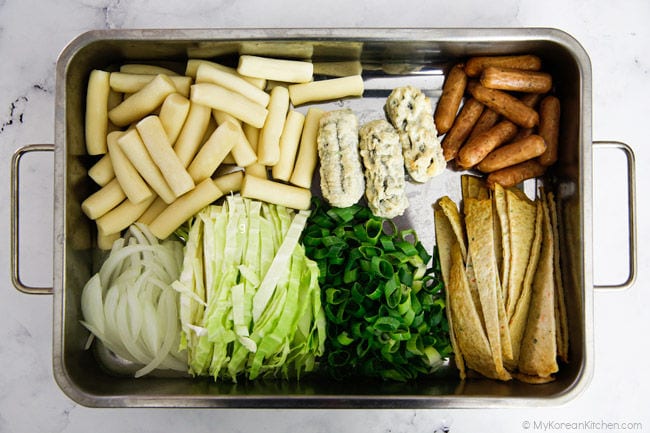
Ingredients for Rose Tteokbokki
Rose Sauce
- 1.5 Tbsp gochujang (Korean chili paste)
- 1.5 Tbsp sugar, raw
- 1.5 Tbsp soy sauce, regular (I used kikkoman brand)
- 1 to 2 tsp (or more), gochugaru (Korean chili powder or chili flakes)
- 300ml (slightly under 1 and 1/4 cup) heavy cream
- 100ml (about 1/3 cup + 1 Tbsp + 1 tsp) whole milk, full cream
Main
- 1 Tbsp cooking oil
- 50g / 1.7 ounces onion, thinly sliced
- 30g / 1 ounce cabbage, thinly sliced
- 15g / 0.5 ounces green onion, thinly sliced
- 320g / 11 ounces Korean rice cake (garaetteok)
- 100g / 3.5 ounces (2 sheets) Korean fish cake, cut into bite-sized pieces
- 90g / 3.1 ounces cocktail sausage (e.g. kabana minis), lightly scored
- 1/2 cup mozzarella cheese, grated
- 1 Tbsp parmesan cheese, grated
Optional or Alternatives
- gimmari (fried seaweed roll)
- flat glass noodles (hot pot glass noodles)
- udon noodles
- bacon
* 1 Tbsp = 15 ml, 1 Cup = 250 ml
** If you want to learn more about Korean ingredients, check my essential Korean ingredients list.
*** If you prefer a spicier flavor, add more gochugaru (Korean chili powder or Korean chili flakes) or use “Maeun Gochugaru” (매운 고추가루), which denotes extra spicy gochugaru.
How to Make Rose Tteokbokki
1. Combine gochujang, sugar, soy sauce, and gochugaru in a small bowl. Mix them well and set it aside.
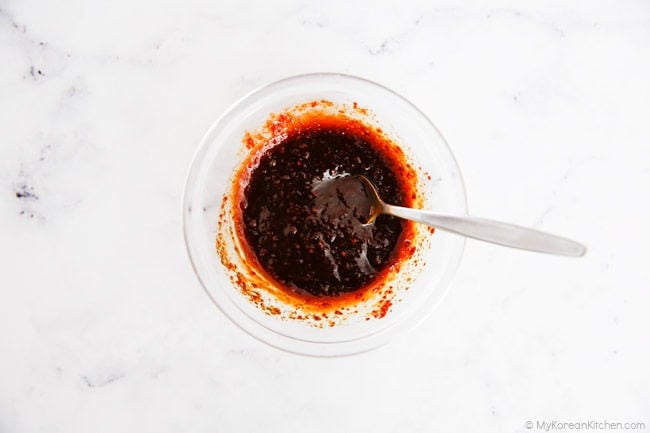
2. In a heated pan, add the cooking oil, then onion, cabbage, and green onion. Stir fry them until lightly wilted, about 3 minutes. Reduce the heat to medium low.
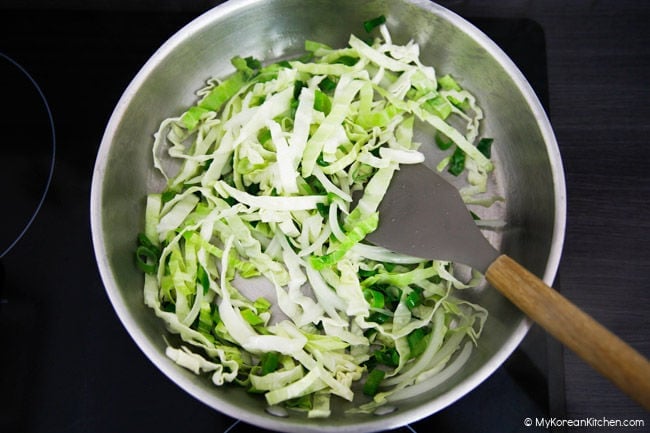
3. Add the gochujang sauce mixture from Step 1, and stir well.
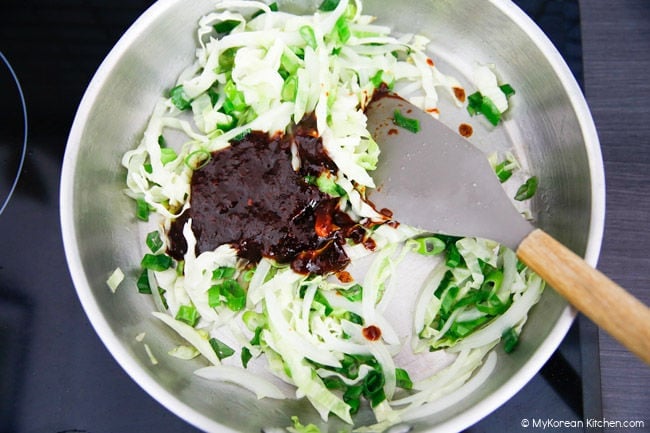
4. Add the heavy cream and milk and stir until fully combined with the gochujang sauce for a smooth, creamy consistency.
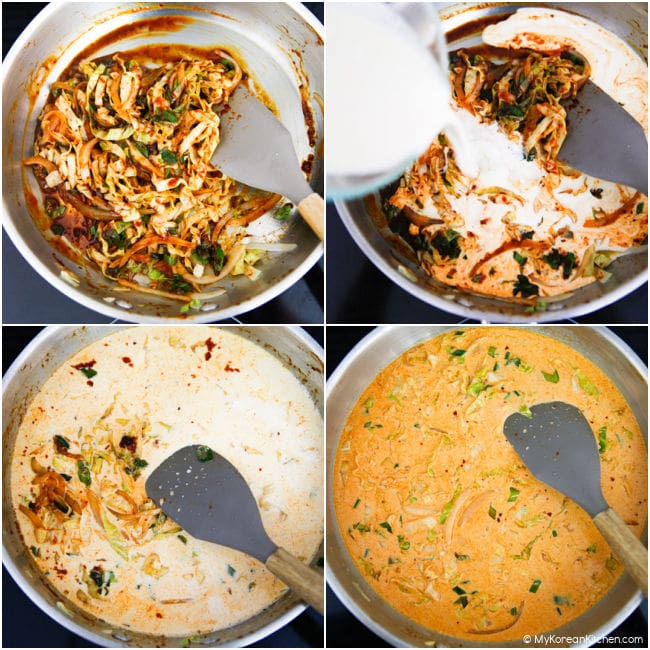
5. Add the rice cakes, fish cakes, and sausage to your pan. Then increase the heat to medium high so the sauce starts to boil. Stir often until the rice cakes have softened, being careful not to overcook them, as overcooked rice cakes can become mushy.
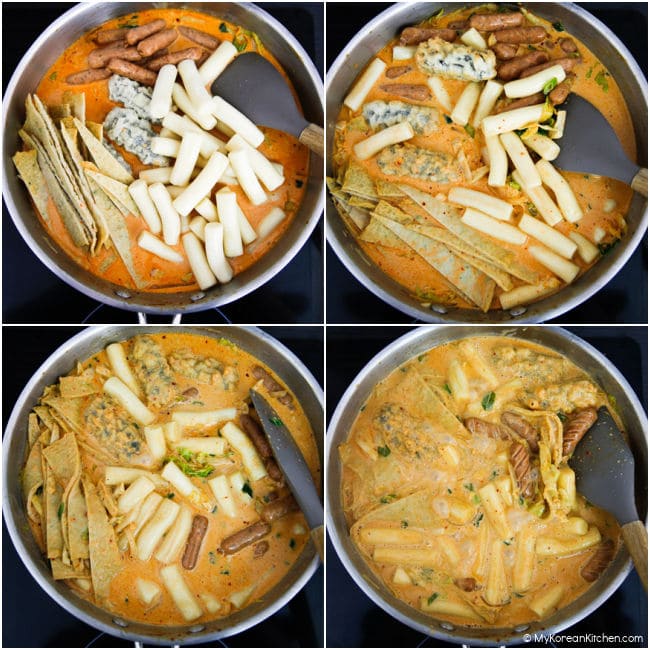
6. Once the sauce is reduced and the other ingredients are evenly coated with it, sprinkle the cheese around the dish evenly. Give it a few moments to melt and produce a cheesy, creamy texture, then serve.
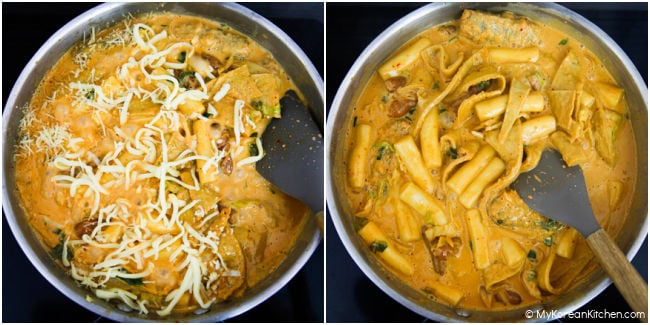

Love Korean food? Browse lots more Korean recipes from my easy Korean recipe collections. And subscribe to my newsletter for all of the latest updates including new recipes, what MKK communities are cooking and K-Dramas!
Watch How I Make It
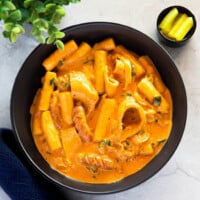
Rose Tteokbokki
Ingredients
ROSE SAUCE
MAIN
- 1 Tbsp cooking oil
- 50 g onion (1.7 ounces), thinly sliced
- 30 g cabbage (1 ounce), thinly sliced
- 15 g green onion (0.5 ounces), thinly sliced
- 320 g Korean rice cake (garaetteok), (11 ounces)
- 100 g Korean fish cake (3.5 ounces), cut into bite-sized pieces
- 90 g cocktail sausage (e.g. kabana minis), (3.1 ounces), lightly scored
- 1/2 cup mozzarella cheese , grated
- 1 Tbsp parmesan cheese , grated
OPTIONAL OR ALTERNATIVES
- gimmari (fried seaweed roll)
- flat glass noodles (hot pot glass noodles)
- udon noodles
- bacon
Instructions
- Combine gochujang, sugar, soy sauce, and gochugaru in a small bowl. Mix them well and set it aside.
- In a heated pan, add the cooking oil, then onion, cabbage, and green onion. Stir fry them until lightly wilted, about 3 minutes. Reduce the heat to medium low.
- Add the gochujang sauce mixture from Step 1, and stir well.
- Add the heavy cream and milk and stir until fully combined with the gochujang sauce for a smooth, creamy consistency.
- Add the rice cakes, fish cakes, and sausage to your pan. Then increase the heat to medium high so the sauce starts to boil. Stir often until the rice cakes have softened, being careful not to overcook them, as overcooked rice cakes can become mushy.
- Once the sauce is reduced and the other ingredients are evenly coated with it, sprinkle the cheese around the dish evenly. Give it a few moments to melt and produce a cheesy, creamy texture, then serve.
Notes
- 1 Tbsp = 15 ml, 1 Cup = 250 ml
- If you want to learn more about Korean ingredients, check my essential Korean ingredients list.
- If you prefer a spicier flavor, add more gochugaru (Korean chili powder or Korean chili flakes) or use “Maeun Gochugaru”, which denotes extra spicy gochugaru.
Nutrition Info (per serving)
The nutrition information shown is an estimate provided by an online nutrition calculator. It should not be considered a substitute for a professional nutritionist’s advice.
